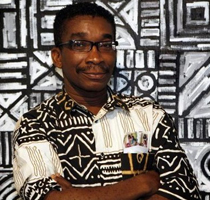In this same incisive and scorching critique, Okwui Enwezor questions why the curators of africa ’95 did not feature artists like Bili Bidjocka, Ike Ude, Yinka Shonibare, Olu Oguibe, Folake Shoga, Kendell Geers, António Ole, Oledele Bangboye, Lubaina Himid, and Ouattara, to name a few; all these artists, interestingly, living in the West. This is the question he posed to the curators:
Why do we never consider the achievements of those artists who at great professional cost and individual isolation have equally transfigured the borders constituting the notion of Africanity? How could anyone serious about contemporary art in Africa overlook the importance of artistic practice that breach the etiquettes of racial determinism and national origin, of boundaries and territories within Africa?
He quips that in the representation of contemporary art from Africa:
 Discussion is never elevated to a pitch that allows for even the most rudimentary debates around contemporary Africa’s post-colonial enunciation, theoretical strategies, and artistic practice. Neither do such conversations ever consider the deep implications of Africa’s post modernity, the locationary and migratory (mental and physical) disruptions, palpably evident in works of artists such as… (Those listed above).
From the above, there is no gainsaying Okwui Enwezor had the obdurate courage and fought gallantly and relentlessly the art establishment, the Euro-American machinery, which was largely unreceptive to contemporary African art, and practiced the policy of exclusion, marginalizing Africa when it came to presenting and discussing global art. Finally the doors were perceptibly opened for Okwui Enwezor to allow his hand-picked artists, mostly African Diaspora artists, into the global discourse, and the doors quickly shut again. Most of the artists just mentioned above and a few more others Enwezor endorsed have all gone on to become world-class artists with highly successful careers, whilst their colleagues back in Africa still operate on the fringes of the art world. Soon after that, this hitherto exclusionary machine had Okwui Enwezor himself swallowed up. Once he found himself in the comfort zone of the curatorial world, in the riding seat of power – unlimited and absolute – he forgot what had originally set him on the crusading war-path for contemporary African art, that he was once knocking obstreperously and noisily on the doors of the Establishment to open up for Africa art. He had laid down his fire, his once peremptory knock, silent. And he was now practicing the very act of exclusion himself – a thing he had once condemned – marginalizing a group of contemporary Africa artists, in fact, nearly all the artists living and working on the mother continent of Africa today.
It is rather ironical that barely a few years ago, Okwui Enwezor’s firebrand style of art criticism was brutally so critical and disparaging of africa ’95, querying the way Africa and its arts were presented in the London metropolis, in a “carnevelisque†manner, which only reinforced the West’s erroneous perception of Africa as backwards or primitive, and its modernity, non-existent. He wrote:
These are the least troubling aspects of what africa ’95 portrayed. Implicit in its mission is the musty arena of egalitarianism, of equal partnership between the organizers and African artists, curators and scholars. But the evidence revealed otherwise. What seemed lost in all the euphoria was the fact that the encounter between Africa and the West often revolves around the discourse of power – the fraught relations between the dominator and the dominated. And nowhere is this made more glaringly valid than in the historicisation of, and debate around the contemporary cultural production of Africa.
For Africa’s contemporary artists working all over the world, the dismissiveness which precedes their entrance and limited incursions into internationalism is a fiercely institutionalized situation…
According to Okwui Enwezor, works which Africans regard as craft, utilitarian objects, are brought to the West and “consistently given the sanction of institutional patronage as the pride of contemporary African presentationâ€. He continues in his indignant denunciation:
The evident astonishment one feels in this foray, into what is supposed to constitute a delimited African art discourse is that while Africa is in the throes of the most brutal evisceration-politically socially and economically, africa ’95 still adopts the most simplistic commentary to address a very difficult subject. This is a dangerous time, especially if one considers that the pendulum of power between the North and the South seems to be swinging towards a re-conquering strategy of double speak and double dealing undefined by the rhetoric of rational logic. Objectivity, here, is only simulated, hiding a prejudiced institutional subjectivity that suppresses any parity in the distribution of resources, space, and access. While the obvious demand is for an involved and rigorous critical discourse, Westerners instead adopt a strategy of isolation that loses contemporary African culture in the peripheral discourses of power, eventually regarding it as inconsequential.





No Comments so far ↓
There are no comments yet...Kick things off by filling out the form below.